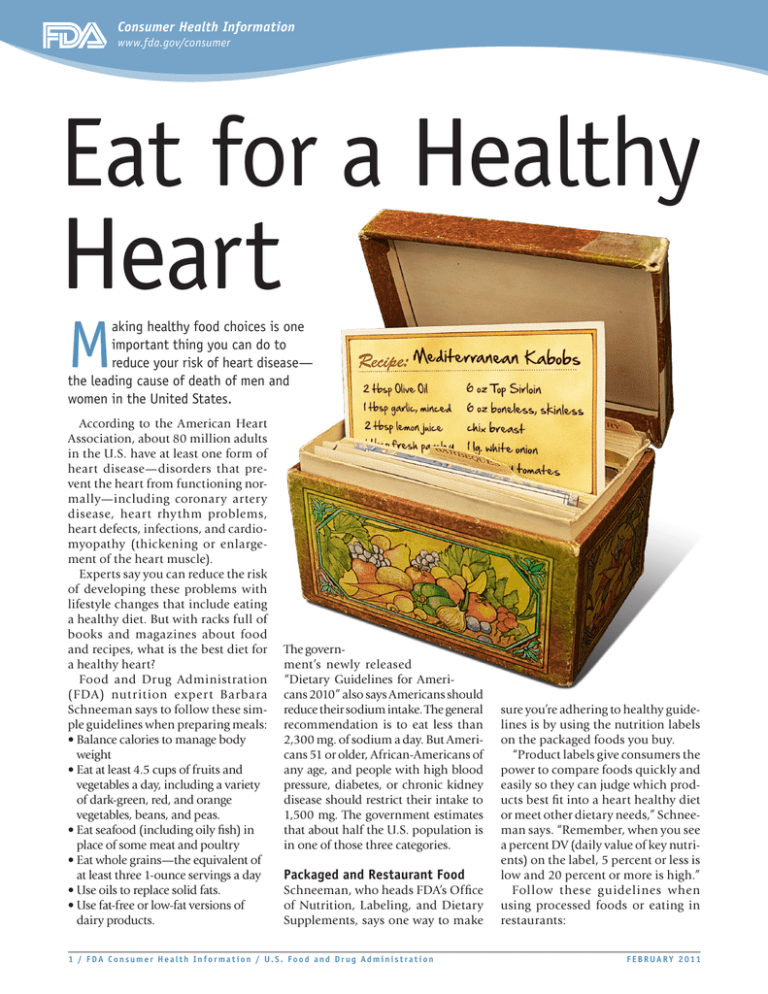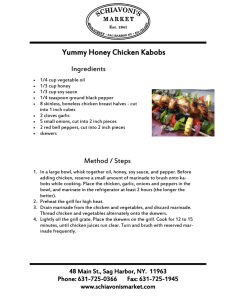Heart Eat for a Healthy M
advertisement

Consumer Health Information www.fda.gov/consumer Eat for a Healthy Heart M aking healthy food choices is one important thing you can do to reduce your risk of heart disease— the leading cause of death of men and women in the United States. According to the American Heart Association, about 80 million adults in the U.S. have at least one form of heart disease—disorders that prevent the heart from functioning normally—including coronary artery disease, heart rhythm problems, heart defects, infections, and cardiomyopathy (thickening or enlargement of the heart muscle). Experts say you can reduce the risk of developing these problems with lifestyle changes that include eating a healthy diet. But with racks full of books and magazines about food and recipes, what is the best diet for a healthy heart? Food and Drug Administration (FDA) nutrition e xper t Barbara Schneeman says to follow these simple guidelines when preparing meals: • Balance calories to manage body weight • Eat at least 4.5 cups of fruits and vegetables a day, including a variety of dark-green, red, and orange vegetables, beans, and peas. • Eat seafood (including oily fish) in place of some meat and poultry • Eat whole grains—the equivalent of at least three 1-ounce servings a day • Use oils to replace solid fats. • Use fat-free or low-fat versions of dairy products. The government’s newly released “Dietary Guidelines for Americans 2010” also says Americans should reduce their sodium intake. The general recommendation is to eat less than 2,300 mg. of sodium a day. But Americans 51 or older, African-Americans of any age, and people with high blood pressure, diabetes, or chronic kidney disease should restrict their intake to 1,500 mg. The government estimates that about half the U.S. population is in one of those three categories. Packaged and Restaurant Food Schneeman, who heads FDA’s Office of Nutrition, Labeling, and Dietary Supplements, says one way to make 1 / FDA Consumer Health Infor mat ion / U. S. Food and Drug Administrat ion sure you’re adhering to healthy guidelines is by using the nutrition labels on the packaged foods you buy. “Product labels give consumers the power to compare foods quickly and easily so they can judge which products best fit into a heart healthy diet or meet other dietary needs,” Schneeman says. “Remember, when you see a percent DV (daily value of key nutrients) on the label, 5 percent or less is low and 20 percent or more is high.” Follow these g uidelines when using processed foods or eating in restaurants: F E B R U A R Y 2 0 11 Consumer Health Information www.fda.gov/consumer Recipe: Mediterranean Kabobs broiled beef & chicken cubes flavored with lemon & parsley For marinade: 2 Tbsp olive oil 6 oz boneless, skinless chicken breast, cut into ¾-inch cubes (12 cubes) 1 Tbsp garlic, minced (about 2–3 cloves) 1 large white onion, cut into ¾-inch squares (12 pieces) 2 Tbsp lemon juice 12 cherry tomatoes, rinsed 1 Tbsp fresh parsley, rinsed, dried, and chopped (or 1 tsp dried) 1 (4 oz) red bell pepper, rinsed and cut into ¾-inch squares (12 squares) ½ tsp salt 12 wooden or metal skewers, each 6 inches long (if wood, soak them in warm water for 5–10 minutes to prevent burning) For kabobs: 6 oz top sirloin or other beef steak cubes (12 cubes) 1 Preheat grill pan or oven broiler (with the rack 3 inches from heat source) on high temperature. 4 Place one piece of beef, chicken, tomato, onion, and red pepper on each of the 12 skewers. 2 Combine ingredients for marinade, and divide between two bowls (one bowl to marinate the raw meat and one bowl for cooking and serving). 5 Grill or broil on each of the four sides for 2–3 minutes or until completely cooked (to a minimum internal temperature of 145 °F for beef and 165 °F for chicken). Spoon most of the second half of the marinade over the kababs while cooking. 3 Mix the beef, chicken, onion, tomatoes, and red pepper cubes in one bowl of the marinade and let sit. After 5 minutes, discard remaining marinade. 6 Serve three skewers per serving. Drizzle the remaining marinade on top of each kabab before serving (use only the marinade that did not touch the raw meat or chicken). For this and other free, heart-healthy recipes and cookbooks---including some in Spanish, visit the National Heart, Lung, and Blood Institute at http://hp2010.nhlbihin.net/healthyeating/Default.aspx?AspxAutoDetectCookieSupport=1. • Choose lean meats and poultry. Bake it, broil it, or grill it. • In a restaurant, opt for steamed, grilled, or broiled dishes instead of those that are fried or sautéed. • L ook on product labels for foods low in saturated fats, trans fats, and cholesterol. Most of the fats you eat should come from polyunsaturated and monounsaturated fats, such as those found in some types of fish, nuts, and vegetable oils. • Check product labels for foods high in potassium (unless you’ve been advised to restrict the amount of potassium you eat). Potassium counteracts some of the effects of salt on blood pressure. • Choose foods and beverages low in added sugars. Read the ingredient list to make sure that added sugars are not among the first ingredients. Ingredients in the largest amounts are listed first. Some names for added sugars include sucrose, glucose, high fructose corn syrup, corn syrup, maple syrup, and fructose. The nutrition facts on the product label give the total sugar content. • Pick foods that provide dietary fiber, like fruits, beans, vegetables, and whole grains. 2 / FDA Consumer Health Infor mat ion / U. S. Food and Drug Administrat ion Feel like getting creative in the kitchen? The National Heart, Lung, and Blood Institute has come up with dozens of delicious heart-healthy recipes—many in Spanish. To get a free cookbook or download recipes, visit http://hp2010. nhlbihin.net/healthyeating. Find this and other Consumer Updates at www.fda.gov/ ForConsumers/ConsumerUpdates Sign up for free e-mail subscriptions at www.fda.gov/ consumer/consumerenews.html F E B R U A R Y 2 0 11




